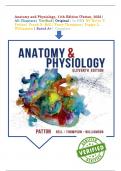Anatomy and Physiology, 11th Edition (Patton, 2023|
All Chapters| Verified| Original| In Pdf| BY Kevin T.
Patton| Frank B. Bell| Terry Thompson| Peggie L.
Williamson| Rated A+| Complete
, TABLE CONTENTS
UNIT 1: THE BODY AS A WHOLE
Chapter 01: Organization Of The Body
Chapter 02: Homeostasis
Chapter 03: Chemistry Of Life
Chapter 04: Biomolecules
Chapter 05: Cell Structure
Chapter 06: Cell Function
Chapter 07: Cell Growth And Development
Chapter 08: Introduction To Tissues
Chapter 09: Tissue Types
UNIT 2: SUPPORT AND MOVEMENT
Chapter 10: Skin
Chapter 11: Skeletal Tissues
Chapter 12: Axial Skeleton
Chapter 13: Appendicular Skeleton
Chapter 14: Articulations
Chapter 15: Axial Muscles
Chapter 16: Appendicular Muscles
Chapter 17: Muscle Contraction
UNIT 3: COMMUNICATION, CONTROL, AND INTEGRATION
Chapter 18: Nervous System Cells
Chapter 19: Nerve Signaling
Chapter 20: Central Nervous System
Chapter 21: Peripheral Nervous System
Chapter 22: Autonomic Nervous System
Chapter 23: General Senses
Chapter 24: Special Senses
Chapter 25: Endocrine Regulation
,Chapter 26: Endocrine Glands
UNIT 4: TRANSPORTATION AND DEFENSE
Chapter 27: Blood
Chapter 28: Heart
Chapter 29: Blood Vessels
Chapter 30: Circulation Of The Blood
Chapter 31: Lymphatic System
Chapter 32: Innate Immunity
Chapter 33: Adaptive Immunity
Chapter 34: Stress
UNIT 5: RESPIRATION, NUTRITION AND EXCRETION
Chapter 35: Respiratory Tract
Chapter 36: Ventilation
Chapter 37: Gas Exchange & Transport
Chapter 38: Upper Digestive Tract
Chapter 39: Lower Digestive Tract
Chapter 40: Digestion And Absorption
Chapter 41: Nutrition And Metabolism
Chapter 42: Urinary System
Chapter 43: Fluid And Electrolyte Balance
Chapter 44: Acid-Base Balance
UNIT 6: REPRODUCTION AND DEVELOPMENT
Chapter 45: Male Reproductive System
Chapter 46: Female Reproductive System
Chapter 47: Growth And Development
Chapter 48: Genetics And Heredity
,UNIT 1: THE BODY AS A WHOLE
Chapter 01: organization of the body
Kevin t. Patton: anatomy and physiology 11th edition, test bank
Multiple choice
1. Which of the following describes anatomy?
A. Using devices to investigate parameters such as heart rate a nd blood
pressure
B. Investigating human structure via dissections and other methods
C. Studying the unusual manner in which an organism responds to painful
stimuli
D. Examining the physiology of life
Ans: b
Dif: memorization ref: p. 3
Top: anatomy and physiology
2. Systemic anatomy is a term that refers to:
A. Physiological investigation at a microscopic level.
B. Anatomical investigation that begins in the head and neck and concludes
at the feet.
C. Anatomical investigation that uses an approach of studying the body by
systems—groups of organs having a common function.
D. Anatomical investigation at the molecular level.
Ans: c
Dif: memorization ref: p. 4
Top: anatomy and physiology
3. Physiology can be subdivided according to the studied:
A. Type of organism
,B. Organizational level
C. Systemic function
D. All of the above are correct.
Ans: d
Dif: memorization ref: p. 4
Top: physiology
4. Physiology:
A. Recognizes the unchanging (as opposed to the dynamic) nature of things.
B. Investigates the body’s structure.
C. Is concerned with organisms and does not deal with different levels of
organization such as cells and systems.
D. Is the science that examines the function of living organisms and their
parts.
Ans: d
Dif: memorization ref: p. 4
Top: physiology
5. One of the basic principles of the standardized terminology is the
avoidance of, or terms that are based on a person’s name.
A. Homonyms
B. Antonyms
C. Eponyms
D. Synonyms
Ans: c
Dif: memorization ref: p. 5
Top: language of science and medicine
6. Metabolism refers to:
A. The chemical basis of life.
B. The sum of all the physical and chemical reactions occurring in the body.
, C. An organization of similar cells specialized to perform a certain funct ion.
D. A subdivision of physiology.
Ans: b
Dif: application ref: p. 5
Top: characteristics of life
7. From smallest to largest, the levels of organization of the body are:
A. Organism, chemical, tissue, cellular, organ, system, organelle.
B. Chemical, microscopic, cellular, tissue, organ, system, organism.
C. Organism, system, organ, tissue, cellular, organell e, chemical.
D. Chemical, organelle, cellular, tissue, organ, system, organism.
Ans: d
Dif: memorization ref: p. 6
Top: levels of organization
8. The smallest living units of structure and function in the body are:
A. Molecules.
B. Cells.
C. Organelles.
D. Atoms.
Ans: b
Dif: memorization ref: p. 7
Top: levels of organization
9. An organization of many similar cells that are specialized to perform a
certain function is called a(n):
A. Tissue.
B. Organism.
C. System.
D. Organ.




